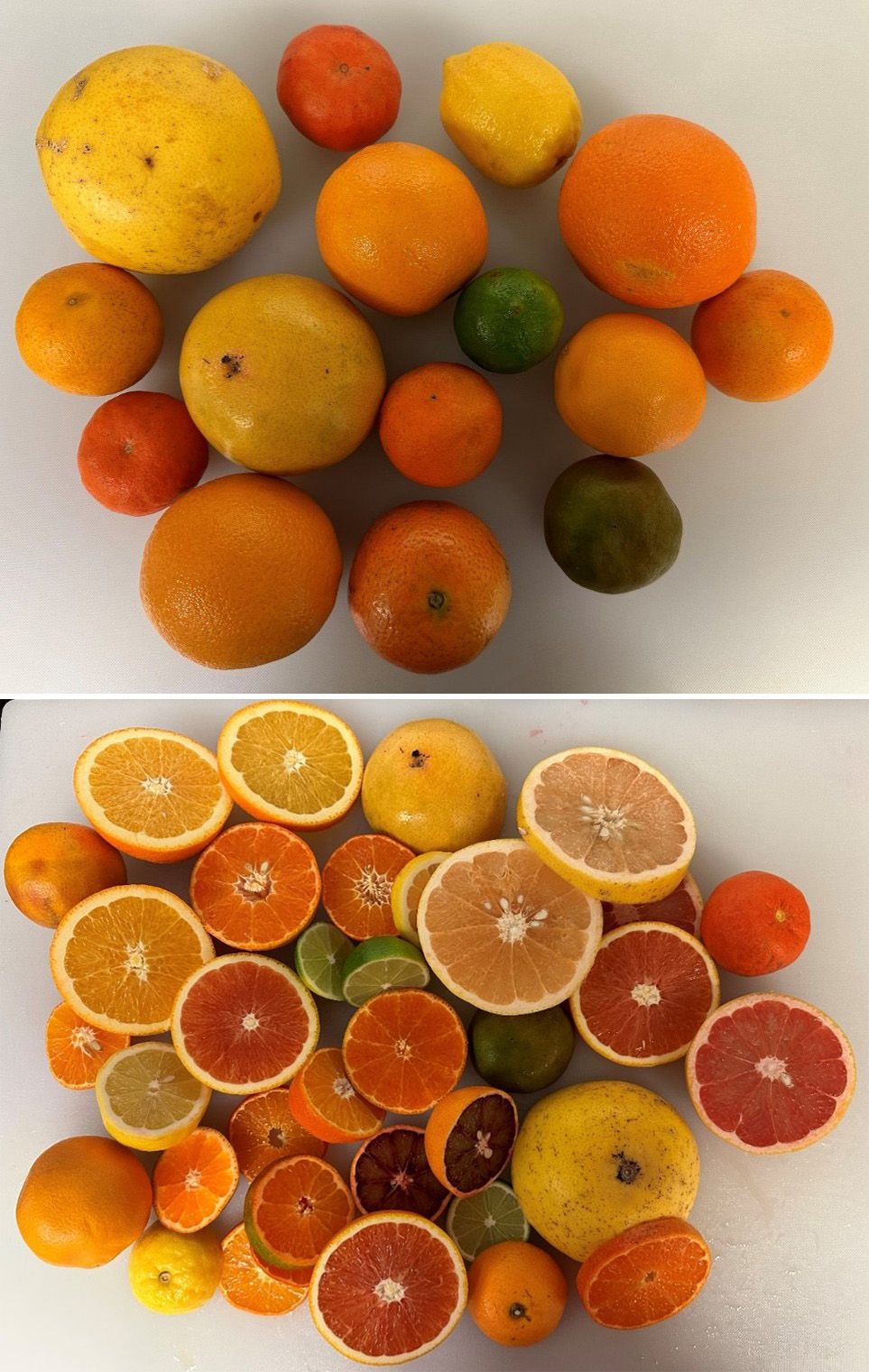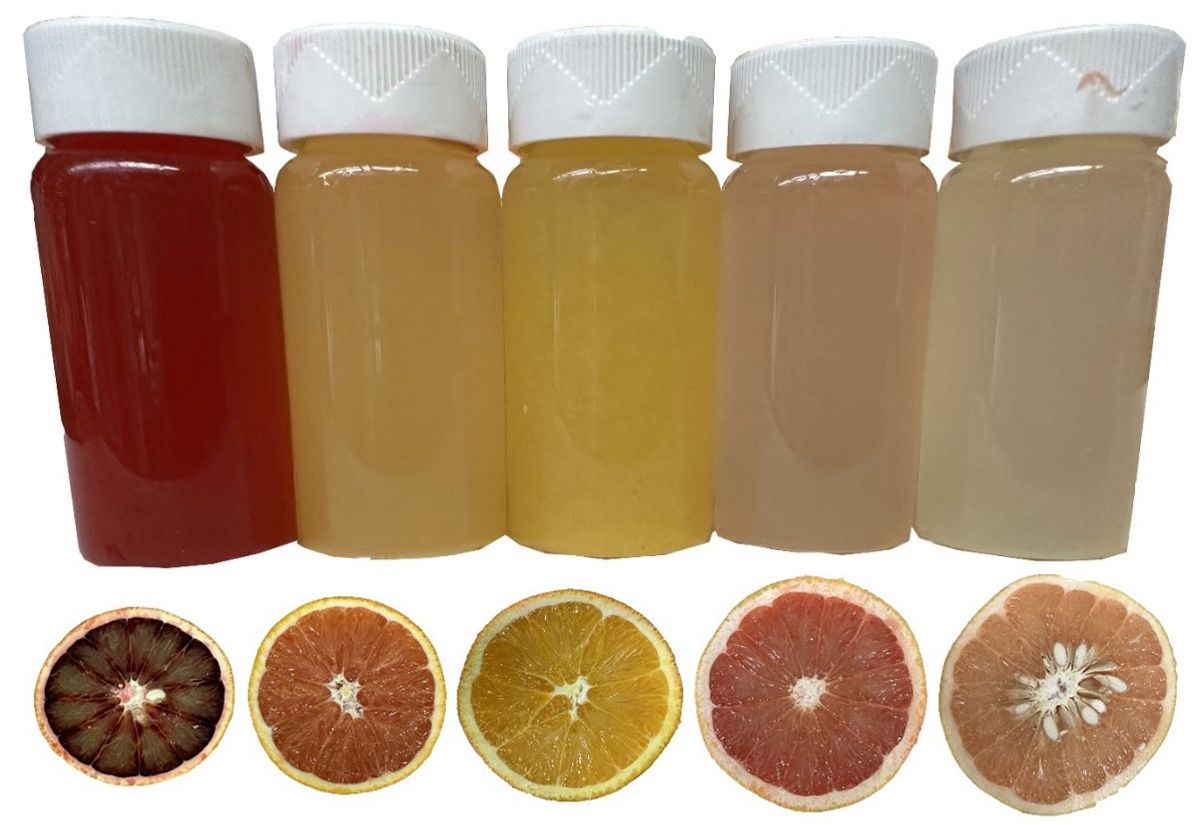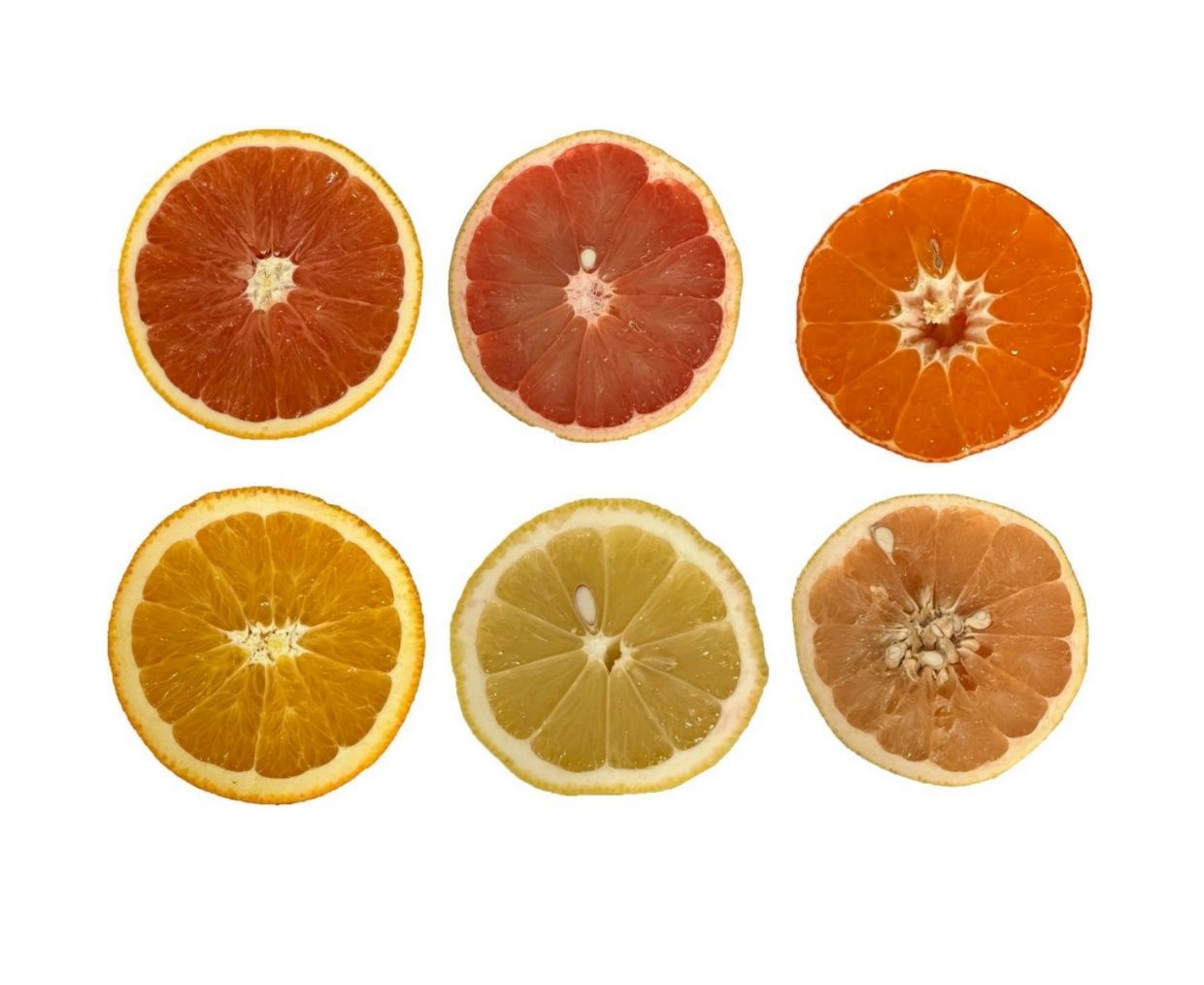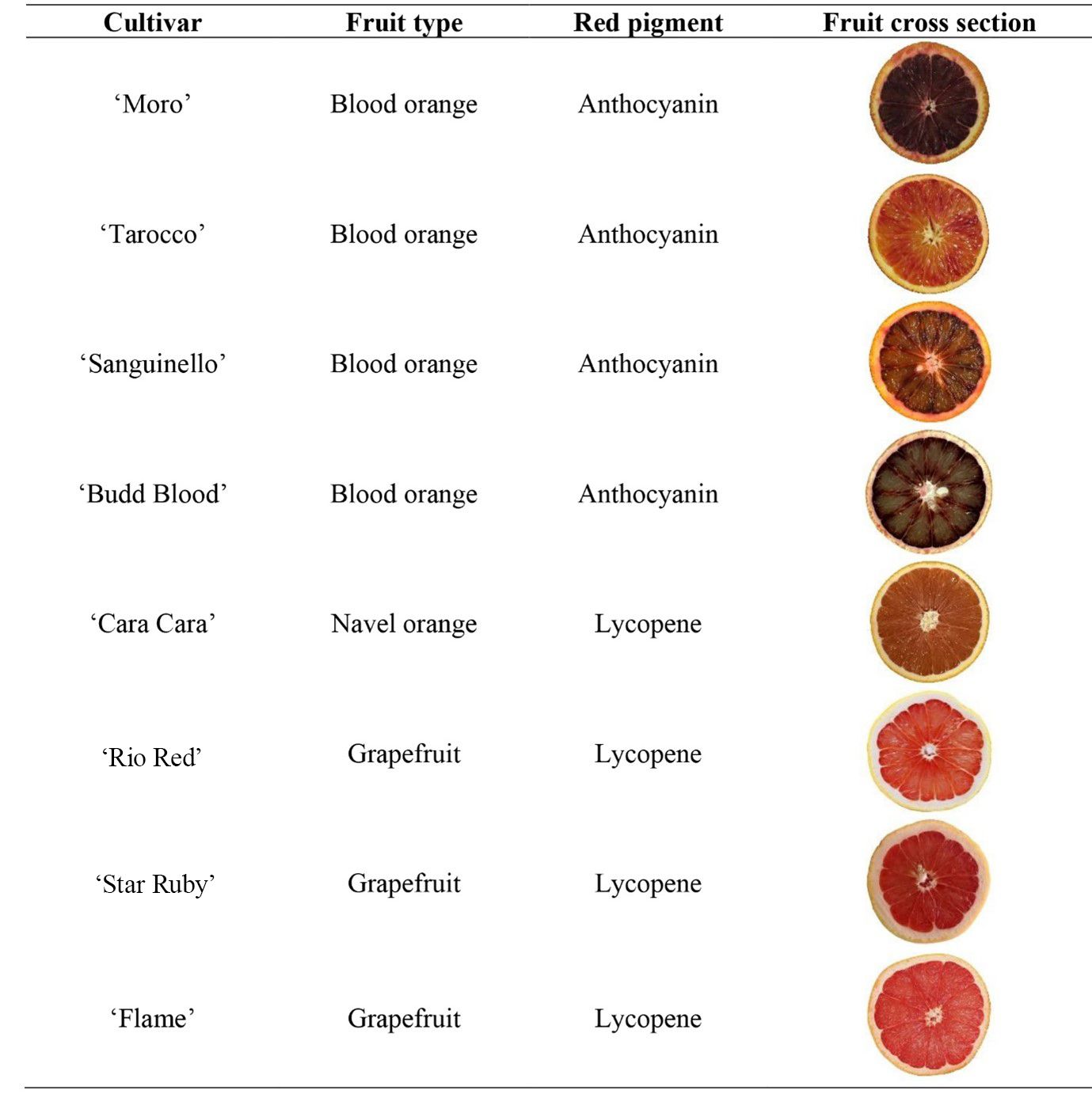Introduction
Citrus fruits are popular among consumers because of their flavor, health-beneficial properties, and nutritional value. The peel and flesh pigmentation of different citrus species and cultivars ranges from green, to yellow, orange, pink, and red. Pigmentation is influenced by genetics, environmental conditions, and tree management. Mature, edible fruit are diverse in size, flavor, and peel and flesh color (Figure 1). The external color of citrus fruits is one of their most important quality characteristics; internal pigment also plays a significant role in determining the health benefits of the fruit. The edible part of citrus fruits, including sweet orange, mandarin, pummelo, grapefruit, lime, and lemon, has distinct attributes and pigments. Consumers can find many types of oranges in the market including navel oranges, juice or common oranges (including Valencia among other varieties), blood oranges (with anthocyanin), and more recently red-fleshed oranges with lycopene (such as 'Cara Cara' navel orange). The term "blond oranges" is sometimes used to refer to the common orange juice oranges. The aim of this publication is to provide an overview of the importance of pigments in citrus fruits, different types of pigments, and their health benefits for people who are interested in citrus fruits.

Credit: F. Habibi and A. Sarkhosh, UF/IFAS
Color Diversity in Citrus Fruits
Citrus species and cultivars exhibit a wide variety of pigmentation. Limes are green, lemons are yellow, and mandarins and sweet oranges are orange and red. Grapefruit and pummelos can be "white" (pale yellow), pink, or red. Internal colors are also diverse. Chlorophylls, carotenoids, and anthocyanins are responsible for the pigmentation of citrus fruits. All citrus fruits initially have chlorophylls as the predominant pigment; however, chlorophylls are degraded, while carotenoids and anthocyanins are synthesized in the fruit of many citrus species (Figure 2).

Credit: Fariborz Habibi and Ali Sarkhosh, UF/IFAS
Main Pigments in Citrus Fruit Species
Pigments in citrus fruits are mostly chlorophylls, carotenoids, and anthocyanins. Chlorophylls are responsible for the green in the fruit peel. As fruit ripen and mature, carotenoids and anthocyanins are responsible for the yellow, orange, and red colors in the peel and flesh (Figure 3). Orange is the standard color of both the flesh and peel of many fully mature citrus fruit species, but a large spectrum of red, pink, orange, yellow, green, and white colors are also common, though more often seen in flesh than in peel. The diversity of flesh colors in citrus fruits is shown in Figure 4. Carotenoids are the pigments in most citrus species and cultivars, while anthocyanins mainly contribute to the red color in a specific group of sweet oranges (blood oranges).

Credit: Fariborz Habibi and Ali Sarkhosh, UF/IFAS

Credit: Fariborz Habibi and Ali Sarkhosh, UF/IFAS
Carotenoids
Carotenoids are the primary pigments that produce red, orange, and yellow colors in most mature citrus fruits. Citrus fruits have complex sources of carotenoids, with a large diversity among the different species and cultivars (Figure 5). Carotenoids are generally higher in the peel than in the flesh due to independent regulation of their synthesis. Carotenoids can be divided into two groups: carotenes and xanthophylls. They produce orange to yellow colors in the flesh and peel. β-Cryptoxanthin and violaxanthin are types of xanthophylls. Violaxanthin has two isomers: all-trans-violaxanthin and 9-cis-violaxanthin. Satsuma mandarin is a rich source of β-cryptoxanthin, which is the major carotenoid found in the fruit’s juice sacs. Violaxanthin accumulates in some sweet orange cultivars like ‘Valencia’, ‘Navelina’, and ‘Hamlin’. Lycopene is a type of carotenoid that is classified as a tetraterpene and is responsible for pink to deep red colors in the juice sacs. In addition to lycopene, other carotenoids are responsible for the color of red-fleshed citrus cultivars, such as ζ-carotene. Because of the great accumulation of lycopene, 'Cara Cara' orange and some grapefruit cultivars, like 'Star Ruby', 'Rio Red', and 'Flame', show pink and red colors in their flesh. Similarly, deeper peel pigmentation of ‘Navel’ orange, compared to ‘Valencia’ orange, is due to a higher concentration of violaxanthin and β-citraurin. Therefore, the main reason for color diversity among citrus species is the different concentrations and compositions of carotenoid types in the juice sac and flesh, as seen in Figures 4 and 5.

Credit: Fariborz Habibi and Ali Sarkhosh, UF/IFAS
Anthocyanins
Anthocyanins are water-soluble phenolic compounds that belong to a subgroup of flavonoids. Anthocyanins accumulate in blood orange cultivars and provide a dark-red coloration. This is mainly in the flesh but can also be in the peel of some cultivars. For example, ‘Sanguinello’ (or ‘Sanguinelli’ in Italy) can produce anthocyanins in both flesh and peel (Figure 6). ‘Moro’, ‘Sanguinello’, and different cultivars of ‘Tarocco’ are commercial blood orange cultivars with different concentrations of anthocyanins. Their red color is different from red-fleshed citrus fruit containing lycopene like ‘Cara Cara’ orange and some grapefruit cultivars (i.e., ‘Star Ruby’, ‘Rio Red’, and ‘Flame’) as described in Figure 7.

Credit: Fariborz Habibi and Ali Sarkhosh, UF/IFAS

Credit: Fariborz Habibi and Ali Sarkhosh, UF/IFAS
Chlorophylls
Chlorophylls are responsible for the green colors of immature citrus fruit and the peel of ripening fruit before the color-break stage. In the context of fruit color development, it is critical to identify the relationship between chlorophyll breakdown and carotenoid biosynthesis. In the field, environmental conditions, especially during cool fall and winter nights, naturally induce chlorophyll breakdown. Similarly, postharvest exposure to low concentrations (3 to 5 ppm) of ethylene, a natural gaseous plant hormone, also triggers chlorophyll degradation. Consequent of this process, the vibrant hues of accumulating carotenoids take center stage, ultimately determining the final color of the fruit (Figure 8). Lime is the only citrus species that is green after maturation and ripening. It can become yellow when left on the tree for longer. Limes are always harvested and marketed prior to that point, to avoid being confused with lemons (Figure 9).

Credit: Fariborz Habibi and Ali Sarkhosh, UF/IFAS

Credit: Fariborz Habibi and Ali Sarkhosh, UF/IFAS
Factors Affecting Citrus Fruit Pigmentation
Genetics, growing conditions, and postharvest factors play essential roles in determining the color of both the peel and flesh of citrus fruit species. In the flesh of citrus fruits, carotenoid biosynthesis occurs in a light-independent manner, allowing carotenoids to accumulate during fruit ripening even without exposure to light. However, it is crucial to note that the carotenoid contents in the juice sacs are generally lower than in the peel of mature fruit that have been exposed to sunlight. This indicates that light plays a critical role in enhancing carotenoid accumulation in citrus fruits. For instance, citrus fruits like mandarin and sweet orange, when located on the outside of the canopy and exposed to sunlight, exhibit a brighter orange coloration, signifying the positive impact of light on carotenoid accumulation in these fruits. Conversely, the influence of light differs for citrus fruit species that primarily accumulate lycopene as the major carotenoid, such as red-fleshed pummelo and grapefruit. In these species, light has a negative impact on carotenoid accumulation, resulting in lower lycopene levels in fruit exposed to sunlight. Therefore, this highlights the difference between carotenoid biosynthesis in the flesh, which occurs independently of light, and the significant impact of light on enhancing carotenoid accumulation in citrus fruits, depending on the specific type of carotenoid involved.
In addition, carotenoid accumulation is sensitive to temperature in citrus fruits. Most citrus fruits need low field temperatures, between 46°F to 59°F (8°C to 15°C), to stimulate natural color break during maturation. However, high temperatures inhibit chlorophyll degradation and carotenoid accumulation in the peel during maturation. For example, fruit grown in subtropical climates develop desirable orange colors, while fruit of the same cultivar grown in tropical climates tend to have pale-greenish peels. Carotenoid accumulation in the flesh can also be affected by temperature. Temperature ranges between 46°F to 59°F (8°C to 15°C) have been reported to be optimal for the biosynthesis of several carotenoids such as β-carotene, β-cryptoxanthin, all-trans-violaxanthin, and 9-cis-violaxanthin. These favorable temperatures contribute to the development of typical orange color in the juice sacs of fruits grown in the tropics, even though the peel may appear pale greenish. Note that the regulatory mechanism of carotenoid biosynthesis differs between the peel and the flesh, allowing carotenoid accumulation in the flesh to remain unaffected by the high temperatures prevalent in tropical regions.
Blood oranges need a wide day/night temperature range to develop high anthocyanin concentrations in the flesh. This can typically be found in Mediterranean climates. In subtropical or tropical climates, commercial production is limited due to very low or lack of anthocyanin concentration at commercial maturity. However, after harvest, anthocyanin concentrations can increase during cold storage and in response to treatment with some elicitor compounds (γ-aminobutyric acid, methyl jasmonate, and methyl salicylate) that can enhance anthocyanin synthesis while controlling chilling injury.
Preharvest and postharvest applications of plant growth regulators, such as ethylene, gibberellic acid, abscisic acid, and auxin, play important roles in the regulation of pigment accumulation in citrus fruit. Postharvest ethylene treatment has been commercially used to stimulate peel de-greening by accelerating chlorophyll degradation and carotenoid accumulation in citrus fruits. It has minor effects on the maturation of citrus juice sacs and does not damage internal fruit quality. In citrus fruit, gibberellic acid (GA) has a negative impact on chlorophyll breakdown and carotenoid accumulation. Pre-harvest GA treatment prior to color break leads to higher lutein content and prevents the accumulation of xanthophylls. Abscisic acid (ABA) is correlated with the color changes from green to orange in citrus fruit. Exogenous application of auxin promotes carotenoid accumulation in citrus fruit after harvest.
Health Benefits
Citrus fruits have high bioactive compounds including polyphenols, flavanones, carotenoids, and ascorbic acid (vitamin C), plus anthocyanins or lycopene in the peel and flesh, but the flesh is the main edible part of the fruit. Consumers associate citrus fruits with these phytochemical compounds that provide their health benefits. Such compounds are recognized to promote health because of their antioxidant, anti-obesity, anti-fatty liver, anticancer, and anti-inflammatory effects, as well as their cardiovascular protection. Their antioxidant activity neutralizes free radicals (which damage our cells if in excess) and reduces oxidative stress-related disorders, helping to mitigate a wide range of diseases such as atherosclerosis, diabetes, neurodegenerative Alzheimer’s, and cancer.
Carotenoids have immense value for human nutrition and health; lycopene, α-carotene, β-carotene, lutein, zeaxanthin, and β-cryptoxanthin are detected at high levels in human plasma. The carotenoids that can be converted to vitamin A in the body are α-carotene, β-carotene, and β-cryptoxanthin.
Anthocyanins have antioxidant activity, which provides human health benefits by scavenging free radical and reactive oxygen species, as well as being antagonistic to some diseases including heart disease (atherosclerosis), arteriosclerosis, cancer, diabetes, and other age-related diseases. Anthocyanins possess antiviral activity as well. Cyanidin 3-glucoside and cyanidin 3-(6″-malonylglucoside) are the major anthocyanins of blood orange fruit, while delphinidin derivatives and peonidin glycosides are present in minor amounts as well. Research shows that these compounds have health benefits, anti-inflammatory capacity, as well as the ability to promote weight loss and prevent obesity. In addition, some studies showed that dietary supplementation with blood orange (‘Moro’) juice significantly decreased body weight gain, fat accumulation, serum triglycerides, and total cholesterol in mice.
In conclusion, the diverse colors in the peel and flesh of different species and varieties of citrus fruits are a result of the presence of different pigment compounds. The array of pigments that are present in citrus fruit peel and flesh is due to the genetics of citrus, fruit maturation and ripening processes, and environmental and hormonal influences. The combination of carotenoid, anthocyanin, and chlorophyll pigments contributes to the captivating colors of citrus fruits. These pigments not only enhance their visual appeal but also offer valuable antioxidant properties that promote various health benefits for humans. Carotenoids and anthocyanins have been extensively studied for their positive impact on health, making citrus fruits valuable for their many human health benefits.
References
Carmona, L., L. Zacarías, and M. J. Rodrigo. 2012. “Stimulation of Coloration and Carotenoid Biosynthesis During Postharvest Storage of ‘Navelina’ Orange Fruit at 12°C.” Postharvest Biology and Technology. 74: 108–117. https://doi.org/10.1016/j.postharvbio.2012.06.021
Chaudhary, P. R., X. Yu, G. K. Jayaprakasha, and B. S. Patil. 2016. “Influence of Storage Temperature and Low-Temperature Conditioning on the Levels of Health-Promoting Compounds in Rio Red Grapefruit.” Food Science and Nutrition. 5(3): 545–553. https://doi.org/10.1002/fsn3.429
Chen, C. 2020. “Pigments in Citrus Fruit: Mutants, Compounds, Genes, and Beyond.” The Citrus Genome, edited by A. Gentile, S. La Mafia, and Z. Deng. 195-209. Cham, Switzerland: Springer. https://doi.org/10.1007/978-3-030-15308-3_11
Chen, C., A. R. Lo Piero, and F. Gmitter. 2015. “Pigments in Citrus.” Pigments in Fruits and Vegetables: Genomics and Dietetics, edited by C. Chen. 165–187. New York: Springer. https://doi.org/10.1007/978-1-4939-2356-4_8
Habibi, F., M. E. García-Pastor, J. Puente-Moreno, F. Garrido-Auñón, M. Serrano, and D. Valero. 2022. “Anthocyanin in Blood Oranges: A Review on Postharvest Approaches for its Enhancement and Preservation.” Critical Reviews in Food Science and Nutrition. https://doi.org/10.1080/10408398.2022.2098250
Habibi, F., A. Ramezanian, F. Guillén, M. Serrano, and D. Valero. 2020. “Blood Oranges Maintain Bioactive Compounds and Nutritional Quality by Postharvest Treatments with γ-Aminobutyric Acid, Methyl Jasmonate or Methyl Salicylate During Cold Storage.” Food Chemistry. 306: 125634. https://doi.org/10.1016/j.foodchem.2019.125634
Kato, M. 2021. “Exogenous Application of Auxin Promotes Carotenoid Accumulation in Citrus Fruit after Harvest.” Acta Horticulturae. 1336: 1–8. https://doi.org/10.17660/ActaHortic.2022.1336.1
Ma, G., L. Zhang, R. Kudaka, H. Inaba, K. Murakami, M. Yamamoto, N. Kojima, M. Yahata, H. Matsumoto, and M. Kato. 2021. “Auxin Induced Carotenoid Accumulation in GA and PDJ-Treated Citrus Fruit After Harvest.” Postharvest Biology and Technology. 181: 111676. https://doi.org/10.1016/j.postharvbio.2021.111676
Ma, G., L. Zhang, and M. Kato. 2023. “Molecular Regulation of Carotenoid Biosynthesis in Citrus Juice Sacs: New Advances.” Scientia Horticulturae. 309: 111629. https://doi.org/10.1016/j.scienta.2022.111629
Ma, G., L. Zhang, M. Sugiura, and M. Kato. 2020 “Chapter 24 - Citrus and Health.” In The Genus Citrus, edited by M. Talon, M. Caruso, F. G. Gmitter Jr. 495–511. Cambridge, UK: Woodhead Publishing, Elsevier. https://doi.org/10.1016/B978-0-12-812163-4.00024-3
Raghavan, S., J. Gurunathan. 2021. “Citrus Species – A Golden Treasure Box that is Beneficial Against Disorders.” Journal of Herbal Medicine. 28: 100438. https://doi.org/10.1016/j.hermed.2021.100438
Rapisarda, P., M. Amenta, G. Ballistreri, S. Fabroni, and N. Timpanaro. 2022. “Distribution, Antioxidant Capacity, Bioavailability and Biological Properties of Anthocyanin Pigments in Blood Oranges and Other Citrus Species.” Molecules. 27(4): 8675. https://doi.org/10.3390/molecules27248675
Rodrigo, M. J., B. Alquézar, E. Alós, J. Lado, and L. Zacarías. 2013. “Biochemical Bases and Molecular Regulation of Pigmentation in the Peel of the Citrus Fruit.” Scientia Horticulturae. 163: 46–62. https://doi.org/10.1016/j.scienta.2013.08.014
Russo, M., I. L. Bonaccorsi, A. Arigò, F. Cacciola, L. De Gara, P. Dugo, and L. Mondello. 2021. “Blood Orange (Citrus sinensis) as a Rich Source of Nutraceuticals: Investigation of Bioactive Compounds in Different Parts of the Fruit by HPLC-PDA/MS.” Natural Product Research. 35(22): 4606–4610. https://doi.org/10.1080/14786419.2019.1696329
Saini, R. K., A. Ranjit, K. Sharma, P. Prasad, X. Shang, K. G. M. Gowda, and Y. S. Keum. 2022. “Bioactive Compounds of Citrus Fruits: A Review of Composition and Health Benefits of Carotenoids, Flavonoids, Limonoids, and Terpenes.” Antioxidants. 11(2): 239. https://doi.org/10.3390/antiox11020239